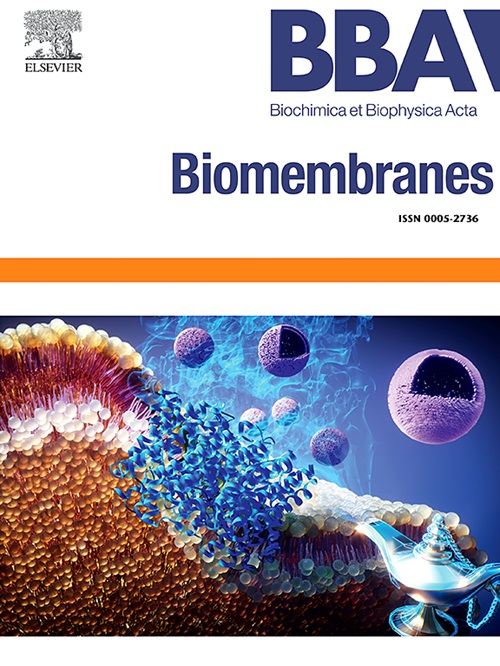The molecular electrometer at 40
IF 2.5
3区 生物学
Q3 BIOCHEMISTRY & MOLECULAR BIOLOGY
引用次数: 0
Abstract
In 1987 Seelig and colleagues proposed that the phosphocholine headgroup of phosphatidylcholine behaved as a universal sensor of surface electrostatic charge, both cationic and anionic, in lipid bilayers (J. Seelig, P.M. Macdonald, P.G. Scherer, Phospholipid Head Groups as Sensors of Electric Charge in Membranes. Biochemistry, 26 (1987) 7535–7541.) Changes in the deuterium NMR quadrupolar splitting measured with specifically-deuterated positions within the choline headgroup in response to surface charges were attributed to a conformational change within the phosphocholine group corresponding to a “tilt” of the choline group towards or away from the direction of the bilayer normal as the P![]() N dipole sought to align with the surface electrostatic field. In the ensuing nearly 4 decades this so-called “Molecular Electrometer” concept has become accepted doctrine in membrane science and has been employed to examine lipid bilayer surface electrostatics in a host of situations involving multiple membrane- associating biologically significant factors from ions, to anesthetics, to peptides and proteins. In this review, I describe the history of the science behind the Molecular Electrometer, the evolution of methods for examining the Molecular Electrometer response and provide a survey of its application in the myriad instances of membrane-associating molecules affecting and being affected by surface electrostatics. Lastly, I include an overview of the efforts of molecular dynamics simulations to be guided by and to account for the Molecular Electrometer effect in simulations of lipid bilayers.
N dipole sought to align with the surface electrostatic field. In the ensuing nearly 4 decades this so-called “Molecular Electrometer” concept has become accepted doctrine in membrane science and has been employed to examine lipid bilayer surface electrostatics in a host of situations involving multiple membrane- associating biologically significant factors from ions, to anesthetics, to peptides and proteins. In this review, I describe the history of the science behind the Molecular Electrometer, the evolution of methods for examining the Molecular Electrometer response and provide a survey of its application in the myriad instances of membrane-associating molecules affecting and being affected by surface electrostatics. Lastly, I include an overview of the efforts of molecular dynamics simulations to be guided by and to account for the Molecular Electrometer effect in simulations of lipid bilayers.
分子静电计在40。
1987年,Seelig和同事提出磷脂酰胆碱的磷脂胆碱头基团在脂质双分子层中充当表面静电电荷的通用传感器,包括阳离子和阴离子(J. Seelig, P.M.Macdonald, P.G. Scherer,磷脂头基团作为膜中电荷的传感器。生物化学,26(1987)7535-7541。在胆碱头基团内特定氘化位置测量的氘核磁共振四极分裂的变化,响应于表面电荷,归因于胆碱基团内部的构象变化,对应于胆碱基团向双分子层正态线方向“倾斜”,因为PN偶极子试图与表面静电场对齐。在随后的近40年里,这种所谓的“分子静电计”概念已成为膜科学中公认的原则,并已被用于检查脂质双分子层表面静电,涉及多种与膜相关的生物重要因素,从离子到麻醉剂,到肽和蛋白质。在这篇综述中,我描述了分子静电计背后的科学历史,检查分子静电计响应的方法的演变,并提供了它在无数膜相关分子影响和被表面静电影响的实例中的应用调查。最后,我概述了分子动力学模拟的努力,以指导和解释分子静电计效应在脂质双层模拟中的作用。
本文章由计算机程序翻译,如有差异,请以英文原文为准。
求助全文
约1分钟内获得全文
求助全文
来源期刊

Biochimica et biophysica acta. Biomembranes
生物-生化与分子生物学
CiteScore
8.20
自引率
5.90%
发文量
175
审稿时长
2.3 months
期刊介绍:
BBA Biomembranes has its main focus on membrane structure, function and biomolecular organization, membrane proteins, receptors, channels and anchors, fluidity and composition, model membranes and liposomes, membrane surface studies and ligand interactions, transport studies, and membrane dynamics.
 求助内容:
求助内容: 应助结果提醒方式:
应助结果提醒方式:


